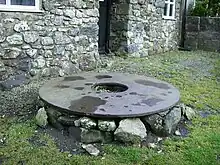Tyring platform
A tyring platform or tyring plate is a circular metal or stone table used for the fitting of a metal tyre or rim to a wooden wheel. These were commonplace when such wheels were needed for the numerous carts, carriages and wagons used throughout society and were standard equipment for a wheelwright.[1]

The tyre or rim would be heated to a high temperature to make it expand for the fitting. The plate was then needed to support the hot metal and the wheel. The heat would typically cause the wooden wheel to catch fire and so water would be used to douse it.[2] The need for a bonfire or furnace to heat the tyres made it efficient to fit several tyres at the same time in a batch and so a strong and stable platform would facilitate this.[3] The platforms would therefore be made of material such as stone or iron. They would typically be circular and large enough to hold the biggest wheels with a hole or rod to secure and locate the hub of the wheel.[4][2]
References
- Edward John T. Collins; Joan Thirsk, eds. (2000), The Agrarian History of England and Wales, 1850 - 1914, vol. 7/2, Cambridge University Press, p. 1168
- Sturt, George (2013-04-16), "The Smith: "Putting-on" and "Boxing-on"", The Wheelwright's Shop, Read Books Ltd, ISBN 978-1-4474-9302-0
- Jack Hargreaves (1986), "Farm Equipment of a bygone age", Out of Town
- Jim Butler (22 April 2023), "Tyring Platforms", Our Wicklow Heritage